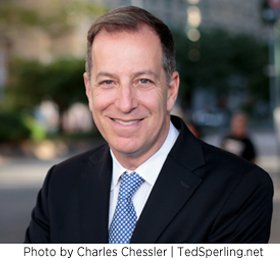Any performance of My Fair Lady is primarily a team effort, but some members of the team deserve notice for the unrelenting demands of their work. The stage managers are among this group, and I will sing their praises eventually. Today, however, I want to focus on Ted Sperling, the musical director for My Fair Lady, a role he has also filled at LCT for The King and I, South Pacific, and The Light in the Piazza, for which he won a Tony for his orchestrations.
I began a recent interview with Sperling in his dressing room by asking him to compare the conducting of My Fair Lady with that of the other LCT revivals. “The nice thing about My Fair Lady,” he replied, “is that there’s quite a bit of new material introduced toward the end. A lot of shows – including The King and I and South Pacific -- rely on reprises toward the finish. But in this show, after ‘Get Me To The Church,’ there’s still ‘Hymn to Him’ and ‘Without You’ and ‘I’ve Grown Accustomed To Her Face.’ It’s very helpful, when a show that's quite long, to have the pleasure of new music right up until the end.”
As for the sound of Lerner and Loewe’s masterpiece, Sperling explained, “It’s so elegant. We have a bigger string section for this show than with the previous LCT revivals I’ve worked on. And strings are what help provide the sense of sheen that My Fair Lady has.”
For Sperling, work on My Fair Lady began long before he picked up the nightly baton. He said that The Frederick Loewe Foundation, which controls the copyrights to the composer’s works, wanted to use the LCT production as an opportunity to take a fresh look at the show’s materials. Very useful in this process was the English scholar Dominic McHugh, the author of Loverly: The Life and Times of My Fair Lady.
According to Sperling, “Dominic compiled a version of the show based more on the original orchestrator’s scores than on the rental materials. We compared that version with the rental materials and recordings to determine whether the show’s creators and their colleagues made changes after the Broadway premiere that should be incorporated in our version or not. This process involved making judgments calls, which could be a challenge, because all the options were good.”
I asked Sperling for new bits that he, with the advice of his expert colleagues – including not only McHugh but Bruce Pomahac, the music consultant to Lerner and Loewe, and Emily Grishman, a music copyist -- decided to use. Sperling provided two examples. The first takes place in the Embassy Ball sequence, where there was a need, for reasons I can’t reveal without being a spoiler, for more music. Sperling said, “I wrote to Dominic. I asked, ‘Is there any cut material from the ball I should look at?’ He sent me boatloads of material, including ‘The Pygmalion Waltz,’ which is an earlier version of ‘The Embassy Waltz.’ It wasn’t longer, just different. We decided to use it in a place other than in the main ball. And in the ball itself, you may notice that in the underscoring there’s music you’ve never heard before.”
Sperling’s second example involved the song “On the Street Where You Live.” He explained: “There’s an earlier version of that song with a completely different introduction. When the show tried out in New Haven, the song was not landing. Some of the team were ready to cut it altogether. Lerner argued strenuously to keep it, saying the reason the song wasn’t landing was that people didn’t know who Freddie was. He had had only a couple of lines in the previous scene, which is where we meet him. Lerner rewrote the beginning of the lyric to recap what has just happened in the Ascot scene, so you remember Freddie as the guy who was charmed by her. The music that went with the original got thrown out. But there are remnants in other places, especially when Eliza goes back to Covent Garden. Bart” – the production’s director, Bartlett Sher – “asked for extra music to cover Freddie’s entrance. I thought: maybe the original verse music could go before the newer verse. So you hear both versions in our production.”
Shortly after LCT’s My Fair Lady opens, it will be recorded for a cast album. “I’m working hard on that project right now,” Sperling said. “We have a time limit, which dictates certain choices. Our recording will last 65 minutes – the original album, with Rex Harrison and Julie Andrews, was 50 minutes – and we’re hoping to include some things not on other cast recordings: some of the reprises, the set-ups for songs, the return to Covent Garden, some dance music.” But not much dialogue, though on that point the new recording won’t adhere to a working philosophy quite as strict as that of Goddard Lieberson, the producer of the musical’s first recording. Lieberson, Sperling said, “was firmly in the camp that you include as little speaking as you can.”
The 1956 My Fair Lady album was a phenomenal success. Why? In part, Sperling explained, because “the recording’s release hit a sweet spot in musical-theater history. Three years later, another album of the show was released, with the London cast and the same three principals. It was also a big hit. In the intervening period, stereo had come in, and a lot of people wanted the show in stereo.”
Perhaps the biggest ingredient in the recordings’ success has to do with the enduring catchiness of the music and lyrics. “I have two seven-year-old daughters,” Sperling said. They probably don’t understand half this show, yet they can sing all the songs.”
Brendan Lemon is the editor of lemonwade.com.
